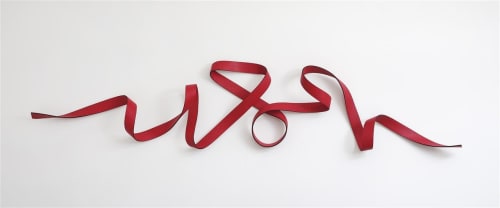With a career spanning more than twenty years, artist and sculptor Ray Haydon is now considered a totara of the New Zealand art world. His exhibition, Voyage, running from 25 October to 27 November at Sanderson Contemporary reflects the significant diversity in his work; combining a suite of newly developed colourful forms, with his classical ribbon-like reliefs in bronze, carbon fibre and wood.
Art critic and academic Rosalind Krauss, wrote that all contemporary sculpture is concerned with the idea of passages.[1] This is certainly true of Haydon’s art, which interrogates the concept of temporality in a multiplicity of ways. Exemplified by simple curvilinear lines that either unfold horizontally or are worked into continuous closed compositions, his sculpture evokes the evolution of form in space, exploring the moments between movement and stillness. The concept of a passage also characterises the time it takes to view Haydon’s sculptures, which are staged as encounters between the viewer and the art. They are designed for the viewer to contemplate, to discover the way that they reflect or deflect light, create shadows and change shape. The works physical prolonged creation also highlights time as practical and performative.
Covid lockdowns over the last two years have proved productive for the artist; providing more time to create art and with shortages of supply resulting in a lack of materials he relished the opportunity to experiment. Haydon’s studio, which overlooks the sometimes frenetic and turbulent Hauraki Gulf, is dominated by a monolithic shimmering tubular work, a continuous curve that folds into an elegant nest. This weighty steel armature is animated by the light and, viewed in the round, the sculpture changes and moves as you walk around it. Unfinished, Haydon says the work will soon be left outside for six months to allow the exterior surface to mature into a russet brown colour, transforming the sculpture once again. Meticulously crafted and deeply concerned with the concepts of motion and time, this studio piece is typical of Haydon’s practice.
Haydon acknowledges that he has a varied practice, but that the foundation of all his work lies in its fluidity; matter slipping through time, often illusory and unseen, but made visible in sculpture. A relief, aptly named ‘Voyage’, also the name of the exhibition at Sanderson, loops and weaves in a kind of dance across the wall; the striking green surface underscores an energetic tempo. This work has conceptual links to early modernist artist Umberto Boccioni, who sought to translate the concept of dynamism, implicit in modern machines, into art. Haydon is a steadfastly abstract artist, rather than representational, and focuses on capturing the intangible. The vivid colours and reflective surfaces seen in his recently developed style of relief (of which Voyage is an example), serve to activate the objects in a new and exciting way, where art stands in as a reflection of the pace of contemporary life and as gestures of an optimistic future.
Sian Abel, October, 2022
[1] Rosalind E. Krauss, Passages in Modern Sculpture, 282.

